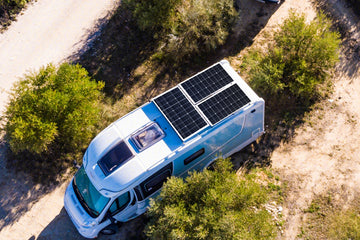1. Introduction
An RV (recreational vehicle) represents a lifestyle that embraces freedom and outdoor living, with one of its core advantages being the ability to function off-grid. Solar panels, as one of the most common and eco-friendly independent power sources, are increasingly becoming essential RV equipment.
This tutorial aims to provide RV owners with a comprehensive, step-by-step installation guide covering everything from component selection and system installation to safety precautions and maintenance. The goal is to ensure stable system performance and extend the lifespan of all equipment.
Solar panels not only provide clean energy for RVs but also reduce reliance on traditional generators and campground hookups. They offer silent, cost-effective, and environmentally friendly power. Since RV rooftops vary in structure and materials, proper selection and installation methods are required to achieve optimal power generation and safety standards.
2. Component Selection Guide
Before installing a solar power system in your RV, it’s essential to understand and select the right components. Proper configuration ensures efficiency and minimizes installation and maintenance difficulties.
2.1 Solar Panel Type Comparison
-
Monocrystalline panels: High efficiency, best for limited rooftop space, though more expensive.
-
Polycrystalline panels: Balanced in cost and efficiency, widely used in RV solar systems.
-
Thin-film panels: Lightweight and flexible, ideal for curved or special rooftop surfaces, though less efficient.
2.2 Other Core Components Overview
-
Charge Controller: Regulates DC voltage and current from solar panels to prevent battery overcharging. MPPT controllers are more efficient and suitable for larger systems, while PWM controllers work for smaller, cost-sensitive setups.
-
Battery Bank: Stores solar energy for later use. Options include lead-acid, AGM, and lithium batteries. Lithium batteries are more durable and efficient but come at a higher cost.
-
Inverter: Converts DC power into AC power for household appliances inside the RV. A pure sine wave inverter is recommended to protect sensitive electronics.
-
Mounting Brackets & Fastening Tools: Options include Z-brackets, L-brackets, and tilt mounts. Rigid panels often require drilling and sealing, while flexible panels may use adhesives like 3M VHB tape.
-
Wires & Connectors: Properly sized cables and MC4 connectors are crucial for safe and efficient power transmission.
3. Detailed Installation Steps
3.1 Layout Planning and Material Preparation
-
Choose installation location: Select areas with maximum sunlight exposure, avoiding air conditioners, vents, or other obstructions.
-
Measure rooftop dimensions: Determine how many panels can fit without compromising the RV’s structure.
-
Gather tools and materials: Panels, brackets, screws, sealant, connectors, wires, and insulation tools.
-
Draw an installation diagram: Plan wiring routes, placement of charge controller and inverter. Place the charge controller close to the battery to minimize losses.
3.2 Installing Mounting Brackets
-
Bracket types: Z-brackets, L-brackets, tilt mounts.
-
Rigid panel installation: Drill holes, secure with screws, and seal with waterproof adhesive.
-
Flexible panel installation: Use strong adhesives or bonding tape to avoid drilling.
-
Key consideration: Ensure firm attachment and avoid obstruction of rooftop equipment.
3.3 Securing Solar Panels
-
Rigid panels: Bolt panels onto brackets and apply sealant around screw holes.
-
Flexible panels: Apply adhesive on the back, ensuring the rooftop surface is clean and dust-free.
-
Tilt angle: For optimal sunlight, angle panels 30°–45° facing south (Northern Hemisphere) or north (Southern Hemisphere). Adjustable mounts can optimize exposure.
3.4 Wiring Design and Cable Routing
-
Cable routing: Use existing roof channels (e.g., fridge vent) if possible; otherwise, drill holes and seal them with waterproof sealant.
-
Parallel wiring: Keeps voltage stable, allows partial shading tolerance, but increases current (requires thicker wires).
-
Series wiring: Increases voltage, reduces current losses, but shading one panel affects the entire string.
-
Safety: Use MC4 connectors, insulate joints, and install fuses for overcurrent protection.
3.5 Connecting the Charge Controller, Battery, and Inverter
-
Charge controller: Install close to the battery in a ventilated location. Correct order:
-
Solar panels → charge controller → battery → inverter/load.
-
-
Battery connection: Use proper cable gauge and install fuses. Double-check polarity to prevent damage.
-
Inverter installation: Mount near the battery for efficiency, ensure good ventilation, and use circuit protection devices.
3.6 System Testing and Commissioning
-
Voltage and current checks: Verify system output with a multimeter.
-
Charging test: Ensure solar panels charge the battery correctly.
-
Load test: Connect common RV appliances (lights, fridge, etc.) and check stability.
-
Monitoring: Record performance during initial use to identify any issues.
4. Precautions and Safety Measures
-
Always disconnect power before working.
-
Use insulated tools for electrical work.
-
Double-check polarity of all connections.
-
Seal all drilled holes with waterproof sealant.
-
Secure all screws, adhesives, and connectors against vibration.
-
Follow electrical codes and consider professional help for complex installations.
5. Maintenance Guide
-
Panel cleaning: Wash regularly with mild detergent and soft brushes to remove dust, dirt, or bird droppings.
-
Wiring checks: Inspect cables and connectors for looseness or corrosion.
-
Battery care:
-
Lead-acid/AGM: Check fluid levels, clean terminals.
-
Lithium: Avoid extreme temperatures, use proper charging management.
-
-
Inverter/controller maintenance: Ensure proper ventilation, clean dust, and check for firmware updates.
-
Structural check: Inspect mounts and adhesives after long trips or vibrations.
-
Storage care: Fully charge batteries, disconnect the system, and cover panels during extended RV storage.
6. Frequently Asked Questions (FAQ)
Q1: Can I connect solar panels directly to the RV battery?
A: No. Always connect through a charge controller to regulate voltage and prevent overcharging.
Q2: How do I size my RV solar system?
A: Calculate your daily energy usage, available rooftop space, and local sunlight hours. Weekend campers may need 200–400W; full-time RVers may require 600–1000W or more.
Q3: What if part of my panels are shaded?
A: Use parallel wiring or adjustable mounts to minimize shading impact.
Q4: Does rooftop material affect installation?
A: Yes. Smooth TPO roofs may require adhesive solutions, while metal roofs allow drilling with proper sealing.
Q5: Why is my system producing low power?
A: Check for shading, poor tilt angle, loose connections, or faulty equipment. Expanding panels or batteries may also be necessary.
7. Summary and Key Findings
-
Component selection: Proper panel type (mono, poly, thin-film), matched with the right controller, battery, and inverter, is critical.
-
Installation steps: Careful planning, secure mounting, proper wiring, and safe connections ensure stable operation.
-
Safety and maintenance: Correct wiring, insulation, sealing, and routine inspections extend system life.
-
Problem-solving: Parallel connections, controllers, and proper placement mitigate common issues like shading and low efficiency.
8. Conclusion
This tutorial provides a complete, practical guide for installing RV solar panels, from planning and equipment selection to installation, testing, and long-term maintenance. By carefully selecting the right components, following a step-by-step installation process, and prioritizing safety, RV owners can build reliable solar systems that enhance their off-grid freedom.
Key takeaways:
-
Select solar panels and components based on actual RV needs and rooftop conditions.
-
Follow strict installation and safety procedures at every step.
-
Maintain equipment through cleaning, inspection, and routine testing.
-
With proper setup, RV solar power delivers freedom, sustainability, and long-term cost savings.


